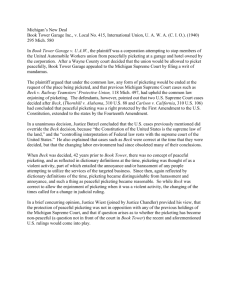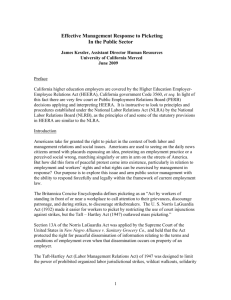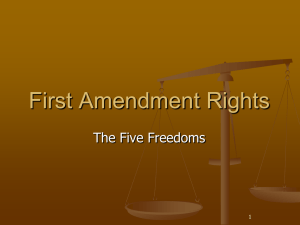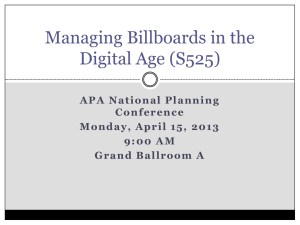Picketing, Protesting, and Advertising: The (un)Holy
advertisement
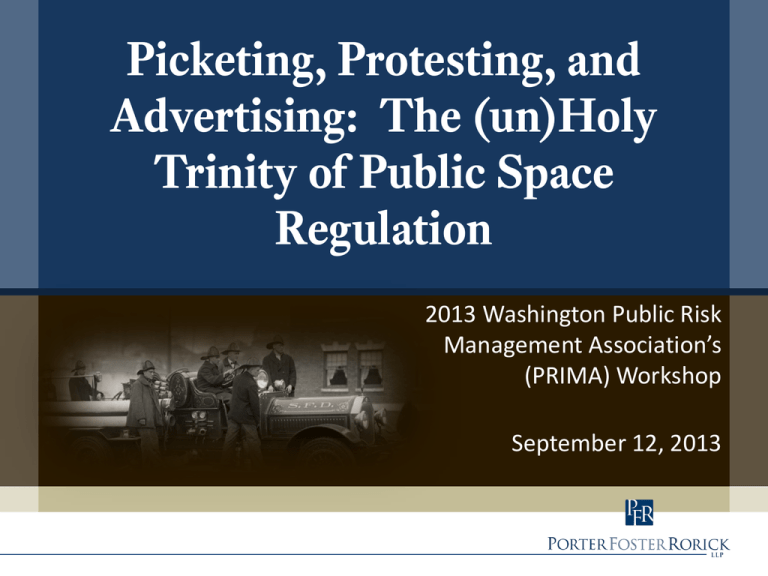
Picketing, Protesting, and Advertising: The (un)Holy Trinity of Public Space Regulation 2013 Washington Public Risk Management Association’s (PRIMA) Workshop September 12, 2013 Key concepts: • • • • First Amendment: assembly and speech Police power Forum analysis Picketing: Protecting vulnerable and captive audiences • Protesting: No protest zones and conduct restrictions • Advertising: Billboards, electronic signs, and hand-bills The First Amendment • Article 1, Section 5 of the Washington Constitution and the First Amendment to the U.S. Constitution protect speech, including picketing, protesting, and advertising. • First Amendment and Article 1, Section 4 to the Washington Constitution, also protect the rights of petition and assembly. The First Amendment “[The] freedom to think as you will and to speak as you think are means indispensable to the discovery and spread of political truth . . . The greatest menace to freedom is an inert people; public discussion is a political duty; and that this should be a fundamental principle of the American government.” Whitney v. California, 274 U.S. 357 (1927). The First Amendment • Regulations must be content/viewpoint neutral • Regulations must focus on time, place, and manner • Regulations must leave open alternative channels of communication Content Neutrality • “The principal inquiry is determining content neutrality . . . is whether the government has adopted a regulation of speech because of disagreement with the message it conveys.” Ward v. Rock Against Racism, 491 U.S. 781 (1989). Narrow tailoring: Adequate Standards • Regulations must be no broader than necessary and contain standards to guide enforcement. “Unfettered discretion”: Intimidates speakers into self-censorship Injects the personal opinions of enforcers Shuttlesworth v. City of Birmingham, 394 U.S. 147 (1969). Alternative Channels of Speech • Government action cannot foreclose “an entire medium of public expression across the landscape of a particular community or setting.” Colacurcio v. City of Kent, 163 F.3d 545 (9th Cir. 1998). • Alternative channel may be “inadequate” if “speaker’s ability to communicate effectively is threatened.” Heffron v. Int’l Soc’y for Krishna Consciousness, Inc., 452 U.S. 640 (1981). Police Power • • • • • • Aesthetics Public safety Hate speech and fighting words Property protection Litter “Misleading” commercial speech Police Power: Aesthetics “Billboards.TimesSquare.NYC.14February2003,” © 2003 Elvert Barnes, http://www.flickr.com/photos/perspective/2236329812 Police Power: Aesthetics • Government has a compelling interest in protecting community from “visual blight.” Metromedia, Inc. v. City of San Diego, 453 U.S. 490 (1981) (ban on offsite billboards constitutional). Police Power: Public Safety “WTO protests 10,” © 1999 Steve Kaiser, http://www.flickr.com/photos/djbones/125523970 Police Power: Public Safety • “No one could seriously dispute that the government has a significant interest in maintaining public order; indeed this is a core duty that the government owes its citizens.” Menotti v. City of Seattle, 409 F.3d 1113 (9th Cir. 2005). Police Power: Hate Speech • Cannot criminalize cross-burning with intent to incite fear on account of race, religion, or gender. R.A.V. v. City of Saint Paul, 505 U.S. 377 (1992) (“St. Paul has sufficient means at its disposal to prevent [cross burning] without adding the First Amendment to the fire.“). Police Power: Hate Speech • But can enact statutes/ordinances that prohibit cross burning with a general intent to intimidate. Virginia v. Black, 538 U.S. 343 (2003) (“The First Amendment permits Virginia to outlaw cross burnings done with the intent to intimidate because burning a cross is a particularly virulent form of intimidation.”). Political Speech • One of the highest protected forms of speech. • Collier v. City of Tacoma, 121 Wn.2d 737 (1993) (striking down pre-election duration restriction on political campaign signs). Forum analysis • (1) Public property that has traditionally been made available as a part of the "privileges, immunities, rights, and liberties of citizens"; • (2) Public property that has been designated by the government as a public forum; and • (3) All other public property. Perry Educ. Ass’n v. Perry Local Educ. Ass’n, 460 U.S. 37 (1983). Traditional Public Forums “May Day march in downtown Seattle,” © 2008 Chuck Taylor, http://www.flickr.com/photos/chuck_taylor/2458411840 Traditional Public Forums • Traditional public forums are those properties that have historically been used for communicative purposes. • Long-term illegal use of government property (e.g., use of mailboxes for purposes other than U.S. mail) does not create a traditional public forum. Traditional Public Forums • Traditional public forums include public streets, sidewalks, planting strips, and parks. • Public forums exist only on main thoroughfares, not walkway leading from parking area to front door. U.S. v. Kokinda, 497 U.S. 720 (1990). Traditional Public Forums • Regulations must be necessary to achieve compelling governmental interest, be content neutral, and allow alternate channels of speech. • Washington’s standard may be more stringent than the federal standard. Collier v. City of Tacoma (“Significant” government interest (federal) vs. “compelling” government interest (state)). Designated Public Forums “Train station, Zurich, Switzerland,” ©2006 Denna Jones, http://www.flickr.com/photos/dennajones/2380196115 Designated Public Forums • Not a traditional forum but created by the government for the purpose of speech • May be limited or unlimited with regard to allowed content. If unlimited, treated like traditional public forum, with heightened scrutiny. DiLoreto v. Downey Unified Sch. Dist., 196 F.3d 958 (9th Cir. 1999). Designated Public Forums • If limited, regulations must be reasonable in light of the purpose served by the forum and be viewpoint neutral • But can discriminate based on content. Diloreto v. Downey Unified Sch. Dist., (can allow paid advertisements for commercial businesses but reject poster of Ten Commandments). Designated Public Forums • Nothing can ignite a controversy like a designated public forum! Firestorms in San Francisco over anti-Islam ads on buses Firestorm on Long Island over ProPalestinian ad in train station “Other” Government Property • Speech may be regulated if the regulations are reasonable in light of the purpose served, and • Are content and viewpoint neutral. Mighty Movers, Inc. v. City of Seattle, 152 Wn.2d 343 (2004) (can prohibit all signs on utility poles because utility poles are not a public forum). Picketing • Picketing is protected speech! But • By nature, picketers “pick” on targeted individuals or groups, so • Courts have generally upheld content-neutral regulations/efforts to protect vulnerable or captive audiences. Picketing • Cannot ban all picketing on public sidewalks surrounding Supreme Court. United States v. Grace, 461 U.S. 171 (1983). • Cannot ban some messages but not others. Police Dep’t v. Mosley, 408 U.S. 92 (1972) (unconstitutional to prohibit picketing within 150 feet of school while allowing picketing within same zone if labor dispute in progress) Picketing • Can adopt local regulations that prohibit picketers from blocking ingress and egress to public spaces like court houses and from snarling crowds at large events. Cameron v. Johnson, 390 U.S. 611 (1968); Heffron v. International Soc’y for Krishna Consciousness, 452 U.S. 640 (1981). Picketing • Can have a local regulation requiring picketers to carry smaller signs if “extremely large or numerous picket signs could interfere with a bus’s operation or with pedestrian circulation on the sidewalk.” Foti v. City of Menlo Park, 146 F.3d 629 (9th Cir. 1998). Picketing • Can prohibit residents from being targeted in their homes. Frisby v. Schultz, 487 U.S. 474 (1988) (“The type of picketers banned by the Brookfield ordinance generally do not seek to disseminate a message to the general public, but to intrude upon the targeted resident, and to do so in an especially offensive way”) . Picketing • Injunction against anti-abortion protesters aggressively picketing physicians’ office and using terms “murder” and “kill” does not violate constitution. Bering v. SHARE, 106 Wn.2d 212 (1986). Picketing: zone of safety • Hill v. Colorado, 530 U.S. 703 (2000) (“The restricted zone’s prophylactic aspect is justified by the great difficulty of protecting, say, a pregnant woman from physical harassment with legal rules that focus exclusively on the individual impact of each instance of behavior, demanding in each case an accurate characterization (as harassing or not harassing) of each individual movement within the 8-foot boundary.”). Picketing: Westboro Baptist Church “Westboro Baptist Church in Madison,” © 2011 “cometstarmoon,” http://www.flickr.com/photos/calistan/6223937128 Picketing: Westboro Baptist Church • Snyder v. Phelps, 131 S. Ct. 1207 (2011). Court upheld reversal of jury verdict against church members in tort lawsuit, finding that the speech was on “matters of public concern” and therefore protected by the First Amendment. Court did not address state/local regulation of funeral picketing. Open question whether funeral attendees are a “captive” or “vulnerable” audience. Picketing • 18 U.S.C. § 1388 and 38 U.S.C. § 2413 create a buffer zone around military funeral services • Funeral picketing laws struck down in Eighth Circuit. Phelps-Roper v. Nixon, 545 F.3d 685 (8th Cir. 2008) (“floating buffer zone”). • But upheld in Sixth Circuit. Phelps-Roper v. Strickland, 539 F.3d 356 (6th Cir. 2008) (buffer from funeral ceremony only). Westboro counter-protests “Unitarian Universalists counter protest Westboro,” © 2011 “cometstarmoon,” http://www.flickr.com/photos/calistan/6223935422/sizes/o/in/photostream/ Protesting “WTO, 10 Years Later,” © 2009 Joe Goldberg, http://www.flickr.com/photos/goldberg/4169721154 Protesting: No-protest Zones • Menotti, 409 F.3d 113. WTO No Protest Zone: Content neutral because it prohibited all protests (even though shoppers, workers, and delegates were allowed to enter) Narrowly tailored to achieve compelling interest of public order because violent protesters were hiding behind peaceful protesters Left open alternative channels because protests allowed across the street from conference Protesting: Conduct Restrictions • Clark v. Community for Creative Non-violence, 468 U.S. 288 (1984). • Can prohibit protestors from sleeping in Layfayette Park/National Mall under contentneutral camping restriction • Sleeping is expressive activity, but alternative channels of expression left open because protestors allowed to put up symbolic “tent cities” Protesting: Conduct Restrictions • Security policy requiring protesters using a public easement through Westlake Center to hold stick-mounted signs pointing down is a reasonable regulation on speech. • Westlake monorail easement is not a public forum. • Policy designed to protect bystanders from getting clocked with signs. Sanders v. City of Seattle, 160 Wn.2d 198 (2007). Protests: Occupy Wall Street etc. • Prolonged protests of “Occupy” movements created public health risks. • Courts upheld efforts by (patient) governments and property owners to evict protesters for public health/safety needs. See, e.g., Waller v. City of New York, 34 Misc. 371 (2011) (“owner has the right to adopt reasonable rules that permit it to maintain a clean, safe, publicly accessible space.”). Protests: Occupy Wall Street etc. “The First Amendment gives every New Yorker the right to speak out — but it does not give anyone the right to sleep in a park or otherwise take it over to the exclusion of others — nor does it permit anyone in our society to live outside the law. The First Amendment protects speech – it does not protect the use of tents and sleeping bags to take over a public space.” – Mayor Michael Bloomberg. Protesting: Prior Restraints (permits) • Courts have generally upheld reasonable requirements for protesters to obtain permits prior to protests of a certain size. • Requirement for permit may not interfere with the timing of the protest, if timing is essential to the message. • Local governments must have clear standards for granting/denying permits. Advertising (commercial speech) • “Proposes a commercial transaction” or is “related solely to the economic interests of the speaker and its audience.” • Concerns lawful activity and not misleading. Central Hudson Gas & Elec. v. Pub. Svc. Comm’n, 447 U.S. 557 (1980). Advertising (commercial speech) • Under Central Hudson, speech must be lawful and not misleading, and regulations must: (1) implement a substantial governmental interest, (2) directly advance that interest, and (3) reach no further than necessary to protect the interest. Billboards – not just for advertising! • Billboards used “. . . to publicize the `City in motion' campaign, to communicate messages from candidates for office, to propose marriage, to seek employment, to encourage the use of seat belts, to denounce the United Nations, to seek support for Prisoners of War and Missing in Action, to promote the United Crusade and to provide directions to the traveling public . . .” Metromedia v. San Diego. Billboards • Can completely ban offsite billboards for aesthetic and safety concerns, but • Cannot ban onsite billboards, and • Cannot ban non-commercial billboards but allow commercial. Metromedia v. City of San Diego; National Advertising Co. v. Town of Babylon, 900 F.2d 551 (2nd Cir. 1990). Electronic signs • Can ban them as long as no exceptions swallow the rule. Naser Jewelers v. City of Concord, 513 F.3d 27 (1st Cir. 2008); La Tour v. City of Fayetteville, Ark., 442 F.3d 1094 (8th Cir. 2006), • Electronic signs are big money! • City codes commonly ban electronic signs in historic districts and non-commercial zones. • City codes may restrict ambient light levels and “dwell time” for traffic safety and aesthetic reasons. Portable signs Portable signs • Ban on some, but not all, portable commercial signs is impermissible restriction on commercial speech. Ballen v. City of Redmond, 466 F.3d 736 (9th Cir. 2006). • Desire to prohibit “white flight” does not justify ban on real estate signs. Winmark Assocs. v. Town of Willingboro, 431 U.S. 85 (1977). Handbills Photos by “Marxchivist,” “thirteenofclubs,” “akeg,” http://www.flickr.com/photos/ Handbills • Common source of citizen complaints • Complete ban on handbills is unconstitutional. Schneider v. State, 308 U.S. 147 (1939). • Distinctions between commercial and non-commercial are suspect. City of Cincinnati v. Discovery Network, 507 U.S. 410 (1993). Handbills • Can enact an ordinance: Prohibiting the throwing of handbills into the wind or on vacant property; Prohibiting handbills on properties with “NO HANDBILLS” or equivalent signage • Consider making “NO HANDBILLS” signs available through local government. Questions? Photo by “auweia,” http://www.flickr.com/photos/9640932@N04/6224809678/
